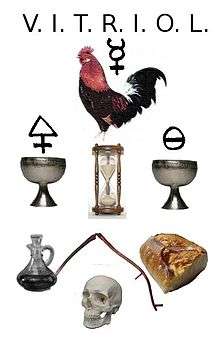Chamber of Reflection
Commonest in the Ancient and Accepted Scottish Rite, the French Rite, and related jurisdictions, including Co-Masonry, the Chamber of Reflection is a small darkened room adjoining the Lodge room. It is a sombre place of meditation and reflection for candidates for initiation into Freemasonry, and is sometimes used in higher degrees.[1] There is no specific list of contents, but it may contain either literally or in representation, such objects or images as a skull, a sickle or scythe, an hourglass, bread and water, sulphur, salt and a cockerel (symbolising mercury), a lantern or candle, or the acronym "V.I.T.R.I.O.L." (see explanation below) Other texts or aphorisms may be written on the wall.

Origins
Little is known about the precise origins of the Chamber of Reflection. There is some consensus that it first appeared in France around 1750, and the Hermetic nature of its symbolism indicates the direct or indirect influence of the Rosicrucians. Author and occultist Robert Ambelain goes as far as suggesting that the Rosicrucians deliberately infiltrated Masonic lodges in order to spread their ideas. Rosicrucian degrees appeared in some French rites during the second half of the eighteenth century (see main article Rosicrucianism). The form of the chamber has hardly changed since then, with minor variations across jurisdictions.[2][3]
Function
Before the ceremony of initiation, the candidate is placed for a time in the Chamber of Reflection, in order to meditate and consider how Freemasonry is about to change his life. He is given a series of questions to answer. Typically, he is asked his duties to God, his fellow men, and himself. In some lodges he is also asked to make a will. At the end of this time, he is led to the Temple for initiation.[1][4]
Symbolism
Although the impact of the chamber's furniture must of necessity be personal, the symbolism relates to hermetic and alchemical correspondences. The chamber itself is symbolic of a cave, introducing the candidate to the alchemical element of earth. (He will meet the others in the temple.) The skull (often with crossed bones) is an obvious symbol of mortality, and coupled with the hourglass, points to the brevity of mortal existence. Bread and water indicate simplicity. The rooster symbolises the alchemical principle of mercury, which partnered with the salt and sulphur, symbolise faith, hope and charity. "V.I.T.R.I.O.L." or vitriol (sulphuric acid) is interpreted as "visita interiora terrae, rectificandoque, invenies occultum lapidem", or "visit the interior of the earth, and purifying it, you will find the hidden stone." This is another way of saying "look within yourself for the truth".[5]
References
- Freemason Information "The Anteroom or Chamber of Reflection", retrieved 24 September 2012
- L'Edifice online Masonic Library "Le Cabinet de Réflexion et ses Symboles", retrieved 28 September 2012
- Propos Maçonniques "Origines Alchimiques du Cabinet de Réflexion", 2011, retrieved 28 September 2012
- Selected Esoteric Readings Giovanni Lombardo, The Chamber of Reflection, from Lodge Room International Magazine, issue June 2006, retrieved 29 September 2012
- Grand Lodge of British Columbia and Yukon Helio L. Da Costa Jr, The Chamber of Reflection, 1999, retrieved 24 September 2012